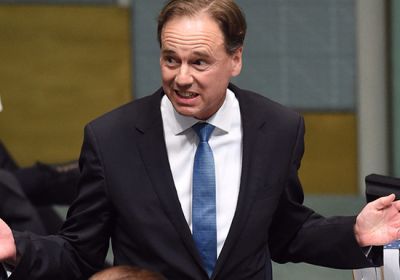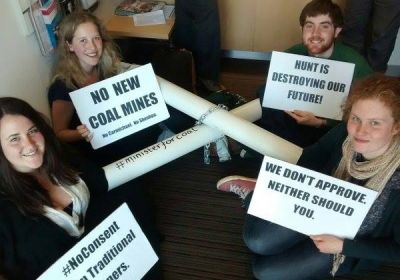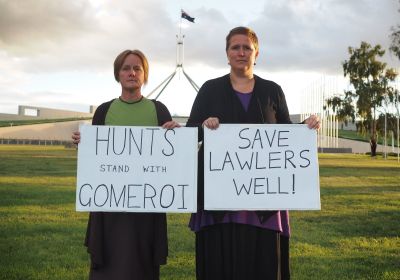-
-
-
Two weeks into a protracted election campaign, it is looking ever-more likely that climate change is to be placed way down the order of business – at least for the major parties. The contest over climate change that characterised the previous three federal elections seems to have disappeared off the political radar despite the issue being more urgent than ever.
-
 At the start of the election campaign federal environment minister Greg Hunt came here to announce $50 million in new projects to boost water quality, including efforts to keep sediment, fertilisers and pesticides off the Great Barrier Reef. This announcement was partly to allay concerns over research showing 93% of the Reef had been bleached and dire predictions that the Reef will be dead in 25 years.
At the start of the election campaign federal environment minister Greg Hunt came here to announce $50 million in new projects to boost water quality, including efforts to keep sediment, fertilisers and pesticides off the Great Barrier Reef. This announcement was partly to allay concerns over research showing 93% of the Reef had been bleached and dire predictions that the Reef will be dead in 25 years. -
 Experts have laughed at a prediction by the environment minister Greg Hunt that Australia’s greenhouse gas emissions peaked 10 years ago. Hunt told the ABC’s AM program: “I believe that we have reached what is sometimes known as peak emissions. In my best judgment … we reached peak emissions in 2005-06 ... and the course of history to come for Australia is that we will continue to be below that figure.” Experts have laughed at a prediction by the environment minister Greg Hunt that Australia's greenhouse gas emissions peaked 10 years ago.
Experts have laughed at a prediction by the environment minister Greg Hunt that Australia’s greenhouse gas emissions peaked 10 years ago. Hunt told the ABC’s AM program: “I believe that we have reached what is sometimes known as peak emissions. In my best judgment … we reached peak emissions in 2005-06 ... and the course of history to come for Australia is that we will continue to be below that figure.” Experts have laughed at a prediction by the environment minister Greg Hunt that Australia's greenhouse gas emissions peaked 10 years ago. -
 Protesters occupied environment minister Greg Hunt's office in Melbourne on October 30, in protest at his re-approval of Australia's largest new mega coalmine — the Adani-Carmichael mine in Queensland. Protesters hung a banner from the roof with “Greg Hunt: Minister for Coal” emblazoned across it. “It is clear that our Minister for the Environment doesn't stand for the environment at all”, said student activist Sam Dariol.
Protesters occupied environment minister Greg Hunt's office in Melbourne on October 30, in protest at his re-approval of Australia's largest new mega coalmine — the Adani-Carmichael mine in Queensland. Protesters hung a banner from the roof with “Greg Hunt: Minister for Coal” emblazoned across it. “It is clear that our Minister for the Environment doesn't stand for the environment at all”, said student activist Sam Dariol. -
 Environment minister Greg Hunt gave formal approval on October 15 for a massive new coalmine in Queensland's Galilee basin, “in accordance with national environment law” after the Federal Court set aside the previous approval in August. But Indian coal mining giant Adani is unlikely to receive the federal government funding it needs to open the Carmichael mega mine. As resource prices crash and more than 1000 coalmining jobs have been lost in Queensland alone this year, Adani's competitors have come out in opposition to any federal government assistance for the mega mine.
Environment minister Greg Hunt gave formal approval on October 15 for a massive new coalmine in Queensland's Galilee basin, “in accordance with national environment law” after the Federal Court set aside the previous approval in August. But Indian coal mining giant Adani is unlikely to receive the federal government funding it needs to open the Carmichael mega mine. As resource prices crash and more than 1000 coalmining jobs have been lost in Queensland alone this year, Adani's competitors have come out in opposition to any federal government assistance for the mega mine. -
 On July 4, federal environment minister Greg Hunt approved the Shenhua Watermark coalmine in the Liverpool Plains in north-west NSW. It will turn 35 square km of prime agricultural land into a giant hole, contaminate aquifers and, as the July 8 Sydney Morning Herald said, “is expected to destroy 789 hectares of an endangered ecological community, much of it box-gum woodland, and 148 hectares of other woods”. The mine will also destroy 800 hectares of koala habitat, condemning the local koala population to extinction.
On July 4, federal environment minister Greg Hunt approved the Shenhua Watermark coalmine in the Liverpool Plains in north-west NSW. It will turn 35 square km of prime agricultural land into a giant hole, contaminate aquifers and, as the July 8 Sydney Morning Herald said, “is expected to destroy 789 hectares of an endangered ecological community, much of it box-gum woodland, and 148 hectares of other woods”. The mine will also destroy 800 hectares of koala habitat, condemning the local koala population to extinction.
Greg Hunt
Greg Hunt

